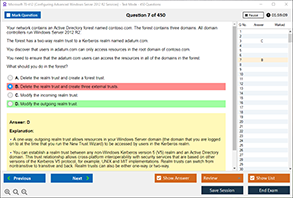Introduction to the Cisco 200-301 Exam
The Cisco 200-301 exam, also known as the Cisco Certified Network Associate (CCNA) exam, is a cornerstone for IT professionals looking to establish a career in networking. This exam validates your ability to install, configure, operate, and troubleshoot medium-sized routed and switched networks. It covers a broad range of topics, including network fundamentals, network access, IP connectivity, IP services, security fundamentals, and automation and programmability.
One of the critical topics within the Cisco 200-301 exam is Cisco Express Forwarding (CEF). Understanding CEF is essential for anyone aiming to excel in the exam and, more importantly, for those who want to optimize network performance in real-world scenarios. In this blog, we will explore what CEF is, its key characteristics, advantages, and how CEF-related questions might appear in the Cisco 200-301 exam.
Definition of Cisco 200-301 Exam
The Cisco 200-301 exam is a comprehensive test designed to assess a candidate's knowledge and skills in networking fundamentals. It is a single exam that replaces the previous CCNA Routing and Switching certification, consolidating multiple tracks into one. The exam covers a wide range of topics, ensuring that candidates have a well-rounded understanding of networking concepts.
The exam consists of multiple-choice questions, drag-and-drop exercises, and simulation-based questions. It is designed to test both theoretical knowledge and practical skills, making it a robust measure of a candidate's readiness to handle real-world networking challenges.
Understanding Cisco Express Forwarding (CEF)
Cisco Express Forwarding (CEF) is an advanced layer 3 switching technology used in Cisco devices to optimize the forwarding of IP packets. It is a proprietary feature of Cisco IOS that enhances the performance of routers and switches by creating a highly efficient forwarding information base (FIB) and adjacency table.
How CEF Works
CEF operates by creating two main data structures:
- Forwarding Information Base (FIB): The FIB is a dynamic table that contains the necessary information to make forwarding decisions. It is essentially a mirror of the IP routing table but is optimized for fast lookups. The FIB contains the next-hop information for each destination network, allowing the router to make quick forwarding decisions without having to consult the routing table.
- Adjacency Table: The adjacency table contains the Layer 2 information needed to encapsulate packets for transmission. It maps the next-hop IP addresses to their corresponding MAC addresses, ensuring that packets are correctly framed before being sent out on the wire.
By using these two tables, CEF can make forwarding decisions at wire speed, significantly reducing the latency associated with traditional routing methods.
Key Characteristics of Cisco Express Forwarding (CEF)
CEF is designed to be fast, scalable, and efficient. Here are some of its key characteristics:
- High Performance: CEF is optimized for high-speed packet forwarding. By using the FIB and adjacency table, CEF can make forwarding decisions in a single lookup, reducing the processing time required for each packet.
- Scalability: CEF is highly scalable and can handle large routing tables with ease. This makes it suitable for use in large enterprise networks and service provider environments where the number of routes can be substantial.
- Load Balancing: CEF supports per-destination and per-packet load balancing, allowing for efficient distribution of traffic across multiple paths. This helps in optimizing network utilization and improving overall performance.
- Recursion: CEF can handle recursive routes efficiently. In traditional routing, recursive routes can lead to multiple lookups, increasing latency. CEF resolves recursive routes in advance, ensuring that only a single lookup is required for forwarding decisions.
- Distributed CEF (dCEF): In high-end routers, CEF can be distributed across multiple line cards, allowing for even greater performance and scalability. Each line card maintains its own FIB and adjacency table, enabling parallel processing of packets.
Advantages of Cisco Express Forwarding (CEF)
CEF offers several advantages over traditional routing methods, making it a preferred choice for modern networks. Here are some of the key benefits:
- Improved Performance: By reducing the number of lookups required for each packet, CEF significantly improves the performance of routers and switches. This is particularly important in high-speed networks where latency can be a critical factor.
- Reduced CPU Load: Traditional routing methods can be CPU-intensive, especially in networks with large routing tables. CEF offloads much of the forwarding decision-making process to specialized hardware, reducing the load on the CPU and allowing it to focus on other tasks.
- Enhanced Scalability: CEF's ability to handle large routing tables makes it highly scalable. This is essential for large enterprise networks and service provider environments where the number of routes can be in the hundreds of thousands.
- Efficient Load Balancing: CEF's support for both per-destination and per-packet load balancing allows for efficient distribution of traffic across multiple paths. This helps in optimizing network utilization and improving overall performance.
- Simplified Network Design: By providing a consistent and efficient forwarding mechanism, CEF simplifies network design and reduces the complexity associated with traditional routing methods. This makes it easier to manage and troubleshoot networks.
Tips for Answering CEF-related Questions
- Understand the Basics: Make sure you have a solid understanding of the basic concepts of CEF, including the FIB, adjacency table, and how CEF improves performance.
- Practice Configuration: Familiarize yourself with the commands used to configure and verify CEF on Cisco devices. Practice using these commands in a lab environment to build your confidence.
- Study Real-world Scenarios: CEF-related questions often involve real-world scenarios. Study how CEF is used in different network environments and be prepared to apply your knowledge to solve practical problems.
- Review Troubleshooting Techniques: Be prepared to troubleshoot CEF-related issues. Understand the common problems that can occur with CEF and how to diagnose and resolve them.
Conclusion
Cisco Express Forwarding (CEF) is a critical technology for optimizing network performance, and it plays a significant role in the Cisco 200-301 CCNA exam. By understanding the key concepts of CEF, its advantages, and how it is implemented in Cisco devices, you can enhance your chances of success in the Exam Dumps and improve your ability to manage and troubleshoot modern networks.
As you prepare for the Cisco 200-301 exam, make sure to dedicate time to studying CEF and practicing related questions. With a solid understanding of CEF, you will be well-equipped to tackle the exam and advance your career in networking. Remember, mastering CEF is not just about passing the exam—it's about gaining the skills and knowledge needed to excel in the ever-evolving world of networking.
Good luck with your studies, and may your journey to becoming a Cisco Certified Network Associate be a successful one!
Special Discount: Offer Valid For Limited Time “200-301 Exam” Order Now!
Sample Questions for Cisco 200-301 Dumps
Actual exam question from Cisco 200-301 Exam.
What are two characteristics of Cisco Express Forwarding (CEF)? (Choose two.)
A. It uses a routing table to make forwarding decisions.
B. It relies on CPU-intensive packet switching.
C. It maintains a Forwarding Information Base (FIB) for efficient lookups.
D. It requires the use of process switching for all traffic.



